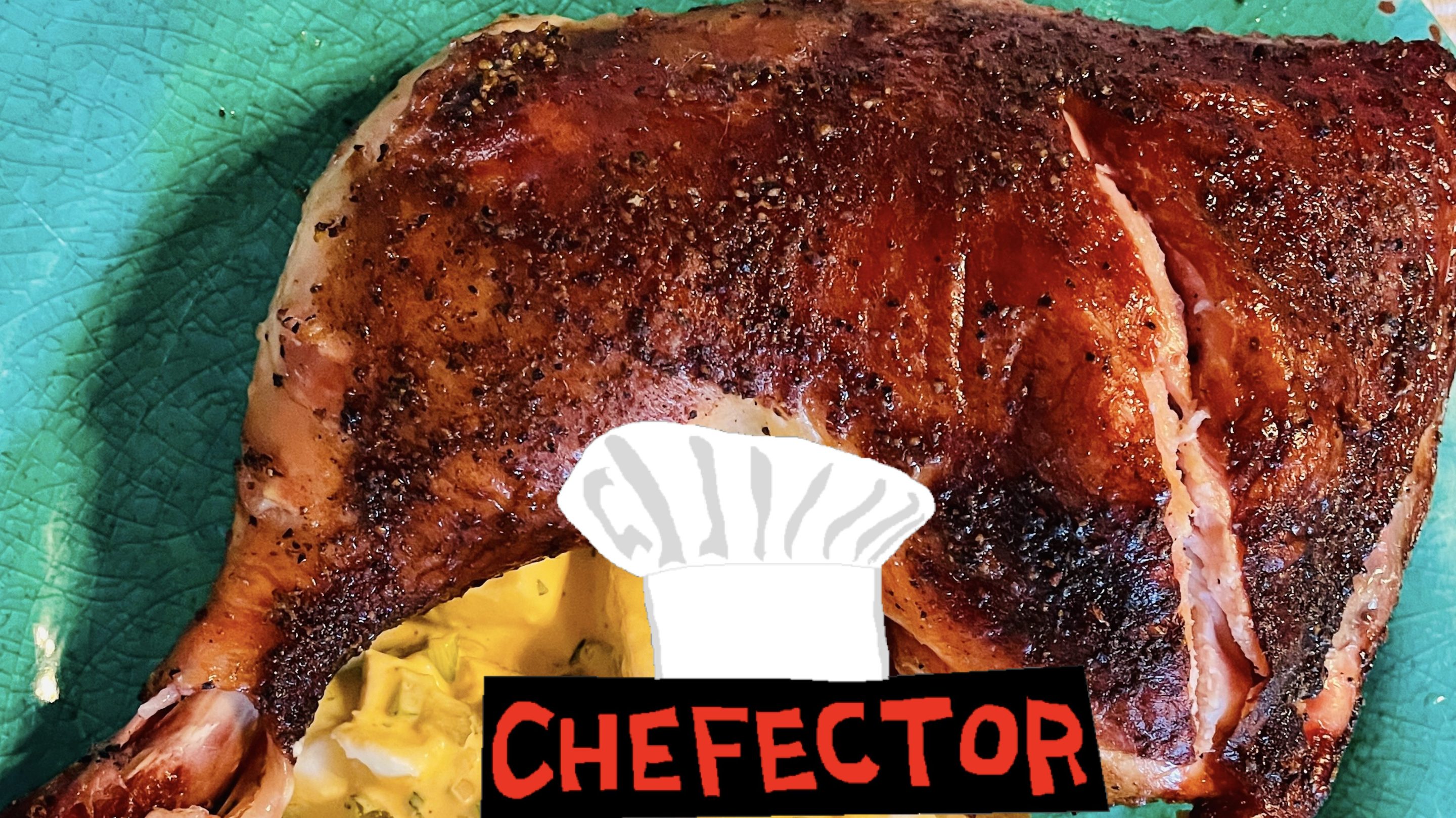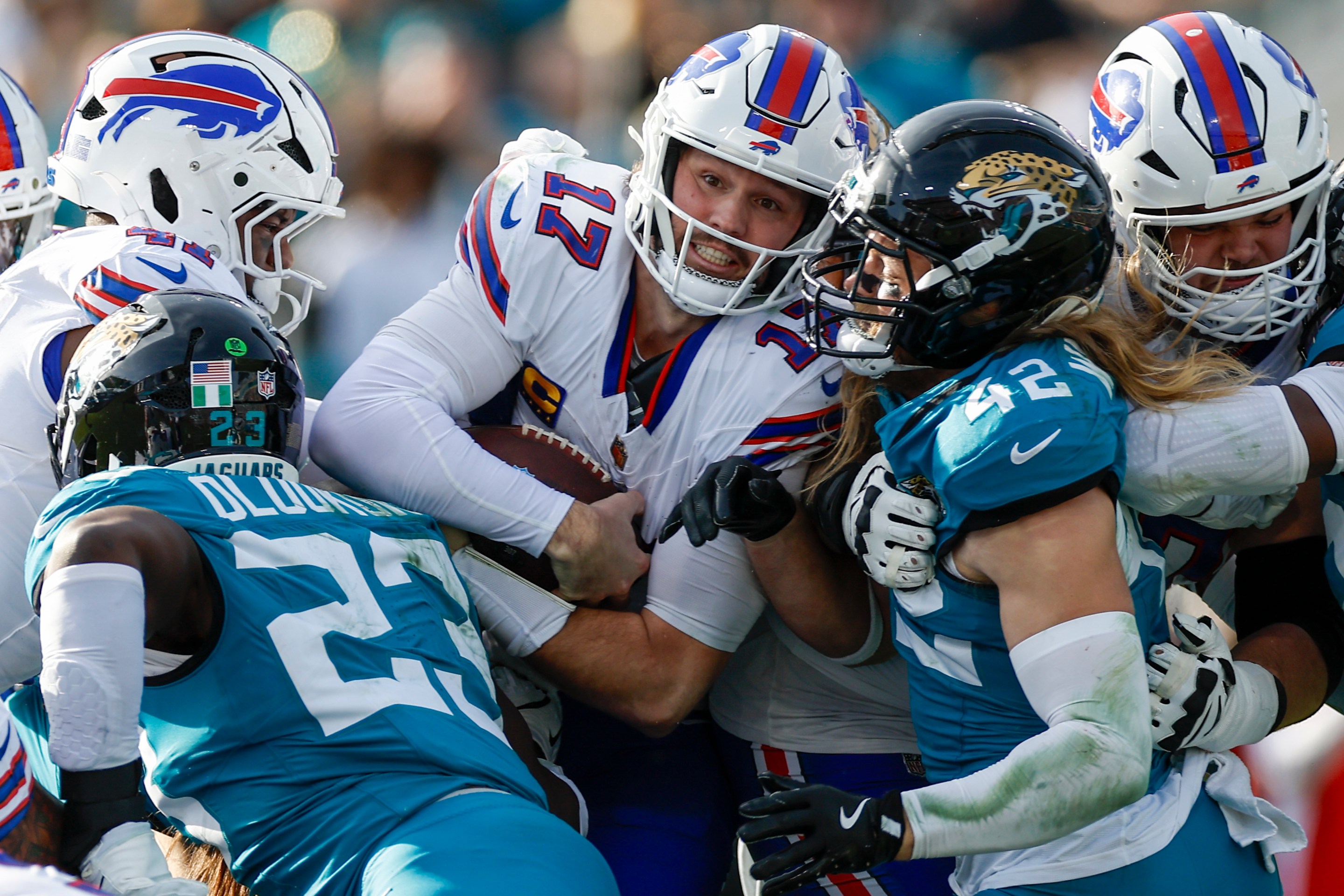Smoking—the cooking method, not the habit—gets a bit of a bad rap. Or maybe not a bad one, just a sort of unhelpful and misleading one.
Cast your imagination backward, into Olden Tymes, prior to the advent of the modern oven. All of the most tender cuts of meat, the ones that can just be eaten without hours and hours of gnawing, are gone; all that is left is this big miserable hunk of muscle and connective tissue. If you skewer it and cook it directly over a hot fire, it will burn into a lump of coal long before any of that connective tissue breaks down enough to render it chewable. At the same time, you cannot just chuck this giant slab of meat into a bog; it's huge, and contains enough nutrition to feed dang near everyone in your, uh, like, village or whatever. Also it came off of a living thing that was killed for its meat, and even as a flinty resident of the Bleak Past, you feel sort of weird about the idea of disrespecting that loss by simply wasting a huge portion of the sustenance it could have provided. What will you do?
Well, Tog over here with the beaver pelt across his nethers has discovered that if you cook this giant wad of meat over a very low fire, for a very long time, when it comes out it will be not just tender enough to eat, but so tender that it melts on your tongue and you sigh deeply and go "Oh God" and then your eyes roll over white and you have a disturbing vision of a distant future in which this foodstuff will be eaten with plastic forks and something called "coleslaw." That's good! The trick is, sustaining a low, controlled fire for the very long time required to cook the Gigantic Meat without ruining it means carefully managing the fire's access to fuel and fresh air, which is kind of a fussy, delicate thing—you may have to dig a hole and bury both the fire and the meat in it for a long time. That's bad! But if you do it right, not only will the meat be tender and juicy and delicious, it will also taste like smoke. Which, our ancestors were probably glad to discover, was good. But it wasn't the point. And it certainly wasn't what made the whole process delicate and difficult. The fact that a brisket is a fucking pain in the ass to cook is what did that part. In fact it's quite easy to make food taste like smoke! You just trap it in a confined space with some smoke for a little while.
Somewhere between that (ludicrous, probably insanely ahistorical) past and modern times, that whole thing got sorta turned inside-out. It's now quite simple to braise a brisket or a pork shoulder or a flank or whatever in a modern oven, with virtually no fussing, and have it come out tender and delicious, which utterly obviates the most difficult part of what the modern grilling dingus has come to know as the cooking technique of smoking: Sustaining a steady low temperature for a very long time so that the connective tissue in that brisket or shoulder or flank breaks down without the whole thing turning to sawdust. The reason to smoke that thing, now—really the only not-vain reason to smoke it—is that you like the taste of smoky meat. But that's the easy part! In fact, it is incredibly easy! You can do it on basically any outdoor cooking apparatus that has a lid. And yet, somehow, smoking still has an entire industry of specialized equipment and shit built around the idea that it is Advanced Cooking Tactics For The Expert Grilling Man.
And really, that's fine: Backyard smokers are fun, and cool, and if you like yours, that rules, sincerely. The only real problem is wherever smoking hobbyism gives your basic Normal person, your casual doofus with no particular part of their identity or self-respect tied to their prowess as an outdoor preparer of meats, the impression that they can't just decide, on a Saturday, that they want some smoky smoked meatstuffs for dinner, with roughly as much planning and foresight as they'd put into whipping up some fish tacos or grilling some burgers. If you have ever felt that way, then I am here to demonstrate—to help you demonstrate for yourself!—that smoking is super duper simple and anybody can do it. My friends, let's smoke some chicken parts on a regular charcoal grill.
This is going to be so easy, and the chicken is going to taste so good, and then you are going to feel 200 percent more confidence around the whole subject of smoking foods, in fact perhaps too confident, and you'll spend way too much money on a gigantic brisket from a specialty artisanal butcher and absolutely fucking ruin it and swear off smoking for 10 years, and then you'll come back to it a little warier and a lot wiser, like Sylvester Stallone in Cliffhanger, and it'll be great. A real journey. Ready? Hell yeah.
Here are some things that you will need.
Let's do the non-food stuff first, and then we'll get to the food stuff. You're gonna need charcoal. This can be the cool jagged hardwood lump stuff or it can be dopey ol' briquets: The major advantage of a pile of hardwood lump charcoal, in grilling, is that it gets super duper hot compared to briquets, which is nice for some stuff but not really necessary here. Go for the dumb match-light sawdust wads! No one is looking (other than several domestic spy agencies, Facebook, Google, Apple, Amazon, and many alarming teen sociopaths in Odessa)!
You will also need some wood chips. Let's discuss that briefly. I have a deep and strong hunch that a very wide variety of wood chips likely are sufficient to the job, vis-a-vis smoking, possibly up to and including, like, the wood chips they scatter around as ground cover at neighborhood playgrounds. On the other hand I have never yet quite possessed the courage and/or madness to just, like, hack up one of the many firewood logs over by the corner of the driveway and use it to smoke some ribs or whatever. If you want to go that route, please, log into the comments below and tell us how it works out!
On the other hand maybe you are not ready for that level of Liver-Eating Johnson-ass shit. That's fine. Nowadays many grocery stores, as well as fancier hardware stores, sell bags of select wood chips expressly for use in smoking food. There are also specialty grilling-supply stores here and there. Very probably, with a bit of hunting around (check out the "seasonal" aisle at your supermarket), you can find a bag of, like, applewood or hickory or mesquite wood chips—even if paying money for a plastic bag of filled with wood chips seems kind of insane.
Dump a bunch of your wood chips into a small or medium saucepan, and cover them with cold water until they're floating. Do this at least an hour before you're going to use them. Soaking them will prevent them from just catching fire when you deploy them later; you'll get a nice smoky flavor, rather than the acrid bitterness of food flavored by a raging inferno.
It is beneath the dignity of a self-respecting food-blogger to list obvious shit like cooking tongs here. I feel it's fairly clear that you will need some type of charcoal grill, or at least a nice deep hole in the ground. Let's talk about the food.
Listen. Smoke whatever the hell you want! I don't give a damn! But if you decide that you want to smoke a pork shoulder or an entire brisket or a freaking watermelon or whatever, then you must understand that the cooking steps down below are going to take some extensive refitting, and that I will not be held responsible for the results. What I recommend, for now, is that you smoke some chicken leg-and-thigh quarters, one per person. The nice thing about these, as a starting point for playing around with smoking food and also just in general, is that they have more than enough flavor and fat all on their own that you pretty much can't screw them up, so long as you don't serve them raw. A dark-meat chicken quarter is not going to subject you to the cruel Brisket Nightmare, where 90 minutes into a frickin' 18-hour cooking process you discover that while you were off using the bathroom and getting a drink of water for three goddamn minutes the temperature spiked a little in your kettle and now, no matter what you do, no matter how ferociously you scream at the heavens for the remaining 16-and-a-half hours, the brisket will come out drier and tougher than you wanted. The temperature can spike all the hell it wants under some dark-meat chicken quarters! You can cook them at 450 friggin' degrees and it's basically fine! The brisket can burn in hell!
You will need salt. You may also want pepper. That's it. If you want to roll with some custom dry spice rub or barbecue sauce or Zany Uncle Cornelius's Sizzlin' Six-Alarm Mango Maruga Scorpion Beer Marinade, that is your business and not mine. But I would just like to observe, here, that if the taste of smoky chicken, seasoned just enough to draw out and deepen its flavor, doesn't sound like it's enough for you without a bunch of other Bold Flavors, that's totally fine—but in that case I wouldn't waste my time smoking the chicken. You can get chicken that tastes like the other stuff in literally like a third of the time. In any event, let's move on to the cooking part.
Un-package the chicken, pat it dry with a paper towel, and season it generously on all sides with salt and black pepper. Arrange it on a plate or series of plates, so that none of the chicken parts have to be stacked on top of each other, and sock it back in the cold fridge, uncovered. This will help the skin dry out a bit, which will make for crispier skin later on.
While it's drying out, prepare your charcoal grill. If it is anything like mine, or like the majority of charcoal kettles, it will have some kind of ventilation holes at the bottom, for intake, and it will have another ventilation deal at the top, for exhaust. This is a pretty straightforward operation and we are not doing Expert-Level shit, here; leave the bottom vents completely open so that your fire (which will be little) has no trouble getting enough air to sustain a cooking temperature, and leave the top vents, oh, let's say halfway open, so that the smoke you're using to flavor your chicken is at least modestly delayed on its way to the exit.
Next, make a little charcoal fire. How little? I don't know how big your charcoal grill is! Maybe it is very small. Maybe it is the size of the Chicxulub Crater. Its size will determine how much charcoal you must light: You want enough hot charcoal to make a cute lil' pile of it way over on one side, so that most of the cooking grate does not have any hot charcoal under it. You're using indirect heat, here, is the idea. My charcoal kettle is 26 inches in diameter; a single chimney-starter worth of charcoal is plenty for this.
In any event, once you have your lil' pile of glowing, ash-covered coals over to one side, it will be time to deploy your wood chips. Online you can find as many different techniques and/or admonishments around this subject as there are chesty dudes with too much time on their hands in the Western Hemisphere. By definition, if you have your own method for doing this, you do not need instructions from me on how to do it; please do what works for you. If you are new to this, the thing to know is that it's completely 100-percent A-OK to snatch a fistful of those wet wood chips out of the saucepan where they're steeping in water, shake off the excess water by wagging your hand around for a few seconds, and then scatter the chips over the burning coals. It's fine! I promise it's fine. Your chicken will taste smoky and good, and that is all that matters here.
Having said that, I must now backtrack a little and say that it's a good idea to get the cooking grate, the chicken, and the lid of the grill (did I mention your grill would need a lid? It'll need a lid!) nearby and ready for quick use before you deploy the wood chips, because this project will benefit from your working smoothly and quickly after the wood chips are in there. Don't flip out and rush and accidentally light your shirt on fire and run around burning alive in haste, here! But yes: Scatter the wood chips, then put the cooking grate on the grill, then arrange the chicken on the part of the grill that doesn't have burning charcoal under it, then clamp the lid on that sucker and set a timer for one hour.
Some grills have a built-in thermometer on the lid that will keep you clued in to the internal temperature of the thing. Others do not. If yours has one, you can tinker around with the vents if you like to see if you can get the heat to settle in somewhere between 220 and 250 degrees. If yours does not have a thermometer, that's fine! As long as your lil' charcoal fire continues Being Hot and possibly even Making Smoke for the duration of that hour, it's fine. The goal of this hour isn't to fully cook the chicken; in fact that's not going to happen in that hour. The goal is to pump those suckers full of smoky flavor for one hour, and all you need for that is some moderate amount of heat and smoke.
Now, depending on how big your grill is, and therefore how much charcoal it has in it, you may worry that the wee little fire in there won't last an hour, even with the lid slowing its consumption of the charcoal. Keep an eye on things. If at some point you have reason to believe the fire is getting dangerously low—the lid seems alarmingly cool to the touch and or has a visible rime of ice forming over it, for example—it's cool to lift it long enough to chuck a few more briquets onto the lil' pile of fuel. That'll just sustain it, though; this fire's not likely to get real-deal hot. And that's OK! It's fine.
At the end of the hour, your chicken will be smoky. It almost certainly won't be cooked! In which case please do not serve it to anyone yet. They'll crap their innards out! Now it's Decision Time.
A thing that happens when you cook bone-in, skin-on chicken at very low temperatures is that the skin, instead of getting crispy and delicious, gets extremely tough and rubbery. No amount of continuing to smoke the chicken at low temperatures will do anything to fix this. That's why you set a timer for one hour: An hour is enough time to get as much smokiness into this chicken as any chicken could ever demand for itself, and then you can move onto finishing the actual cooking of this chicken in a way that will render its skin crispy (and its flesh, uh, cooked through and safe to eat).
You can decide for yourself how you want to do this. You can remove the chicken to some kind of temporary lodging (a foil tray, for example), take the cooking grate off the grill, dump more charcoal in there until you have a fire that can sustain genuine roasting temperatures (so, like, 400 degrees), then stick the chicken back in that sucker and clamp the lid back on for a little while (say, 45 minutes to make up for how cool the chicken will get while it waits around for the fire to build back up?). Or you can go back a few paragraphs in this blog, pretend that there was a bolded clause in there about preheating your oven to 400 degrees and covering a baking pan with aluminum foil, and sock your smoky (and still hot!) chicken in the 400-degree oven on that foil-lined baking pan for 20 minutes to half an hour. Either is fine; decide for yourself whether the added deliciousness imparted by roasting over a hot charcoal fire is worth the extra time it'll take to build the fire back up.
Incidentally, the latter approach, with some temperature variations depending on the toughness of the meat in question, applies to a wide range of meat-smoking procedures. An hour of steady uninterrupted smoking will be plenty of time to impart a vivid smoky flavor to, for example, a rack of ribs or a pork shoulder of reasonable proportions. (As for the famed pink "smoke ring," it's more-or-less a myth and doesn't have much of anything to do with smoke, though it does look pretty.) After that, if getting all of this shit done somewhat more quickly and with infinitely less fussing over a moody pile of burning wood is a priority for you, you can move the whole operation to a preheated oven. Or you can keep smoking it in the smoker, if that's what you prefer! It's fine. It's all fine.
Whichever way you went, your dark-meat chicken quarters are done when they hit 165 on a thermometer jammed into the deepest part of the area where the leg and thigh meet (without touching bone), or when you cut into one and it's, uh, visibly cooked all the way through. Remove the chicken from wherever it's cooking and give it some time, maybe 20 minutes or so, to rest under a tent of aluminum foil. You can whip up some other cookout-type stuff with that time, or throw together some sticky-sweet barbecue sauce if you have decided that's how you want to roll, or blow some soap bubbles and watch them drift around. Then it will be time to eat. You know how to do that part, presumably.
That wasn't so hard! Ultimately it did not involve a whole lot of fussing, nor any equipment more specialized than that bag of wood chips. You made some smoke, you trapped some chicken in a confined space with it for a while, and presto, out came some chicken that tastes smoky and delicious, that's still juicy and/or crispy in the places. I recommend twisting the leg and thigh apart from each other and wolfing them down with your bare hands. I recommend getting grease on your face and smiling greasily across a table at somebody with a mouthful of chicken, outdoors and in the sunshine, and being happy.






